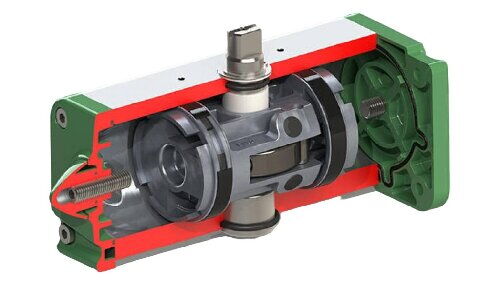How to Enhance Pneumatic Actuator Switching Speed
On this page
When it comes to enhancing the switching speed of pneumatic actuators, taking effective measures is crucial. This not only improves production efficiency but also ensures the stability and reliability of equipment under dynamic operating conditions. Pneumatic actuators, as core components driving valve opening, closing, or modulation, play a pivotal role in industrial automation and process control. Therefore, optimizing their switching speed has become a key focus. Below are detailed explanations of several effective methods to enhance pneumatic actuator switching speed and their advantages in industrial applications.
Enhancing the switching speed of pneumatic actuators is crucial for improving efficiency and responsiveness in industrial automation and process control. Here are effective methods to achieve this.
Adding an intermediate tank next to the pneumatic actuator allows instrument air to enter the reservoir before being supplied to the actuator. This method is particularly suitable for large control valves or applications with high air consumption. The intermediate reservoir stores a sufficient volume of air, ensuring adequate pressure for quick actuation when needed.
The purpose of installing a storage tank is not to increase inlet air pressure but to maintain a constant pressure source. This method is useful in situations where the inlet pipeline is small and air supply is limited. For critical valves, the accumulator serves as an emergency air source reserve. It ensures that the actuator operates normally even when the air supply is insufficient.
To achieve faster switching of pneumatic actuators, upgrading to larger diameter air supply pipes increases the volume of air entering the system, thus accelerating actuator response. For larger valves, consideration can be given to adding accumulators. Larger air supply pipes reduce air flow resistance, enhance air flow velocity, and thereby reduce the response time of actuators.
Enlarging signal piping and installing accelerators can also enhance the switching speed of pneumatic actuators. Accelerators provide greater force during signal transmission, ensuring rapid actuator response.
Pneumatic actuators typically include an adjustment valve to maximize opening. Additionally, increasing signal source pressure or pipe diameter, and enlarging air supply pressure and pipe size, or even expanding cylinder aperture and accelerating exhaust valves, all contribute to improving switching speed. Adjusting valve opening directly impacts airflow volume, thereby influencing actuator switching speed.
When selecting pneumatic actuators, consideration should be given to valve switching time requirements, including unloaded and loaded torque. Ensuring a safety margin for torque, factors such as intake and exhaust speed of pneumatic actuators, enlarging exhaust pipes and pneumatic accessories, and selecting air control valves and quick exhaust valves should be considered. Proper selection maximizes the performance of pneumatic actuators to meet the demands of various operating conditions.
Pneumatic actuators offer several advantages that make them highly suitable for various industrial applications.
Pneumatic actuator shafts enable precise and repeatable control with accuracy up to 0.25%. This high precision control capability makes them excellent for applications requiring precise control.
Unlike electric actuators, pneumatic actuators are less susceptible to temperature effects and are not prone to damage from internal condensation or water ingress through conduits. The stability of pneumatic systems is particularly evident in extreme environments, ensuring long-term equipment stability.
Operated by compressed gas, pneumatic actuators are clean and environmentally friendly, eliminating issues such as oil leakage common in electric actuators and making maintenance easier. The cleanliness of pneumatic systems reduces maintenance costs and environmental pollution risks.
Pneumatic actuator shafts can accept continuous air signals, delivering linear displacement (with an electric/air conversion device, they can also accept continuous electric signals) or angular displacement when paired with a rocker arm. This diverse control capability suits various control requirements.
In case of power failure, pneumatic actuator shafts can fail-close, preventing backflow drainage or overflow from filters, thereby enhancing safety. The power failure protection feature of pneumatic systems is crucial in emergencies, ensuring the safety of equipment and personnel.
Through these methods and advantages, significant improvements in pneumatic actuator switching speed can be achieved, ensuring stable and efficient operation under various conditions. Correct selection and maintenance further enhance the performance and reliability of pneumatic actuators. In practical applications, choosing appropriate optimization methods based on specific circumstances maximizes the advantages of pneumatic actuators, providing reliable assurance for industrial production.

